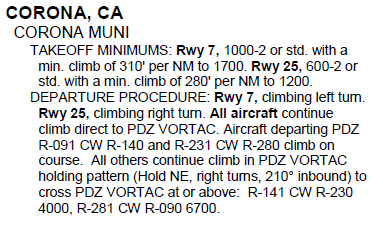I-11: Meeting your Arc Enemy
Corona to Victorville, VOR/DME RWY 17
Recommended aircraft: fast piston (Beech Baron, Piper Seneca) , slow piston (Cessna Skyhawk, Piper Warrior)
Depart from Corona (KAJO) to Victorville (KVCV), filing PDZ V442 APLES. File an altitude appropriate for your easterly flight, above the published Minimum Enroute Altitude (MEA) associated with the airway.
On departure, fly the published Obstacle Departure Procedure (ODP) to include the hold at PDZ, even if the aircraft is high enough to not warrant the holding procedure. Pilots should inform ATC of their intention to fly the ODP and the hold once airborne so that ATC will anticipate the need for the hold. Request the VOR/DME RWY 17 approach into KVCV, flying the arc from APLES intersection. Fly the approach to minimums, execute the missed approach. Note: X-Plane's nav database uses 109.40 as the VCV VOR frequency whereas the real world frequency is 109.05.
During the missed approach, once clear of the Victorville Class D airspace, cancel IFR and return to Victorville VFR and execute a full
stop landing. Pilots who are not yet familiar with the procedures are encouraged
to research the topic through other references, especially the topic of flying DME arcs.
The required/recommended material list has been left empty, as it's expected that pilots are able to retrieve Airport Facility Diagrams and instrument approach plates at this stage of the program. The ODP is available in the Special Takeoff Minimums publication, available through various sources, including Skyvector and MyAirplane (see the attached links). At the time of writing, this information is no longer available at AirNav.com.
The ODP is included inline here as a discussion point, but pilots should be become equally comfortable retrieving them through public sources as they should be consulted as part of standard IFR flight planning in cases where course guidance is not provided to the first fix.

Reviewing the ODP, it can be summarized as follows: Turn towards PDZ VORTAC (left turn off rwy 7 or a right turn from rwy 25). If you'll be departing PDZ on a course of 091-140, or 231-280, you can continue on course after PDZ. Otherwise, HOLD NE at PDZ on the 030 radial, right turns) to cross PDZ at or above 4000 (courses 141-230) or 6700 (281-090).
Careful study of review of V442 prior to the flight will provide the necessary course information to make intelligent decisions regarding the execution of the holding requirement at PDZ.
| Related Materials |
| ZLA - Practical Test Standards |
| Practical Test Standards
list of requirements for all ratings
|
| ZLA - Reference |
| IFR Cruising Altitudes |